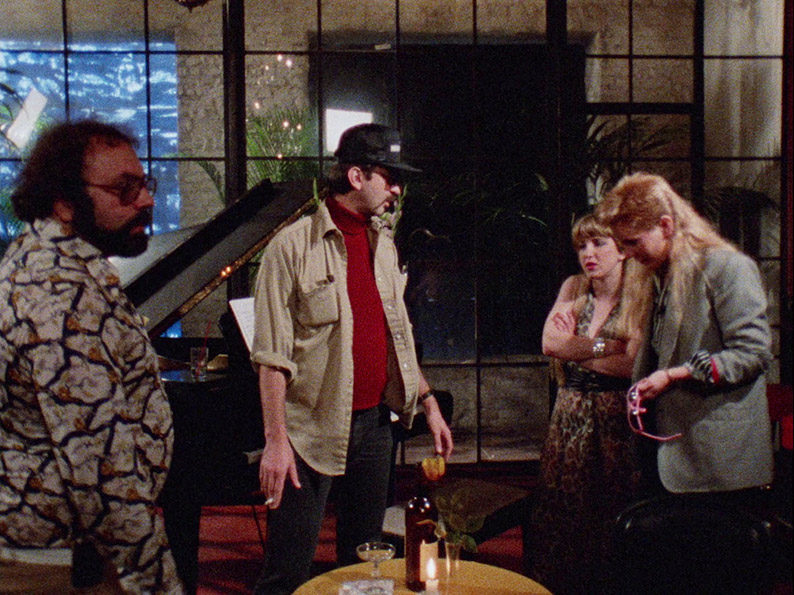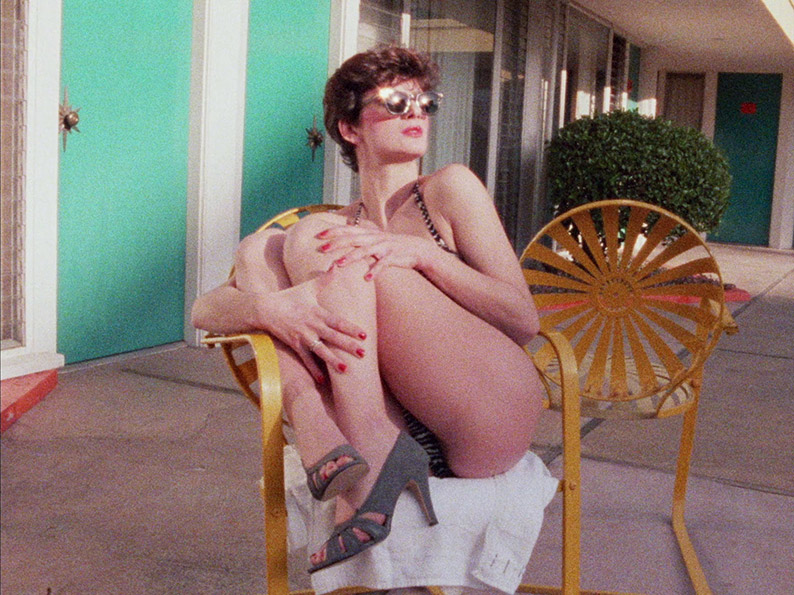| "I get paid to wait around between shots. I don't get paid to act. I do that all the time." |
| Sharon Mitchell |
Kamikaze Hearts comes on like a documentary. Everyone on screen is playing themselves, or at least the names they are professionally known by. Yet the film deliberately blurs the line between "truth" and "fiction". Which is which? Does it matter? The person the film centres on, Mitch (Sharon Mitchell) is openly playing a role, that of herself. As she says towards the end of the film, "I'm always fucking acting. That's all I know how to do."
Mitch met her girlfriend Tigr (pronounced "Tigger", played by Tigr Mennett, also the film's associate producer and co-writer) on Sulka's Wedding, a porn movie about transwoman Sulka's wedding day, with a cast made up largely of trans people and other non-binary identities. Mitch and Tigr were the only cisgender women on screen, and their love affair began when they filmed a sex scene together. The film depicts the ups and downs of their relationship, and their history in the porn industry, combined with fly-on-the-wall footage of a porn shoot – though not a real one, as it was staged for the film without telling most of the cast. Director Juliet Bashore and her cinematographer David Golia use different 16mm film stocks for different parts of the film: warmer Kodachrome tones for the film within the film and a grainier, slightly bluish, look for the "documentary" parts. Mitch is centre stage throughout: answering questions from the audience while kneeling naked on stage, having sex on camera, even at one point doing an eye-watering contortionist act. As for the central couple, they refer to the film as a "docu-dreama".

Drugs as well as sex feature in Mitch and Tigr's relationship. Towards the end of the film, Mitch holds up a needle to camera and says, "This was my dick. I fucked her with my dick." As for the sex, Mitch says that for her it only becomes real when it's photographed, and that no one can touch it, not even the cameraman. Well, maybe an editor could. As with anything else in this film, the act remains poised on the division between reality and artifice. The film is also a record of a porn industry that no longer exists, a time when the movies were shot on film (16mm or even 35mm) rather than on video, and before AIDS and its heterosexual transmission cut a swathe through the community. Mitch in her later career was heavily involved in setting up healthcare initiatives for adult film performers.
Made in 1986, Kamikaze Hearts was often uneasily programmed in film festivals as a documentary, and it quickly gained a cult following a few years before New Queer Cinema arrived in the early 1990s. It had a UK cinema release in 1990. After its commercial release, it often circulated in nth-generation bootleg copies, but now it has been restored and is available again.
Kamikaze Hearts has been released by the BFI on a single Blu-ray disc encoded for Region B only. The film had an 18 certificate on its cinema release and still has one. At the time of writing, the reissue trailer and the Susie Bright and Sharon Mitchell interviews also appear on the BBFC site, all with 18 certificates.
The film was shot in 16mm and this Blu-ray transfer is based on a 2K scan of the original negative. The aspect ratio is 1.33:1, which is as you would expect from a film shot in and as far as I'm aware only distributed in 16mm. (I saw it on release, but don't remember very much about it, let alone its aspect ratio.) As mentioned above, different film stocks were used, one more grainy than the other. The colours are strong and vibrant, and that grain does look filmlike. There are occasional scratches and tramlines visible, but nothing too distracting.
The soundtrack is the original mono, rendered as LPCM 2.0. It's occasionally a little rough-sounding, with some distortion of sibilant sounds, but that's no doubt due to the production. English subtitles are available for the hard of hearing, and I didn't spot any errors in them
special features.
Audio commentary with Juliet Bashore, Sharon Mitchell, Jon Martin, Howie Gordon and Shelly Mars
This commentary was recorded in 2022 and features the director and two actors from Kamikaze Hearts, plus actor Howie Gordon (known professionally as Richard Pacheco) and performance artist Mars. There isn't a lot of overlap between this and the often extensive interviews on the disc, and comes over as a meeting of old friends. We do get some technical details from Juliet Bashore, but much of the track is taken up with reminiscences, including noting those people no longer with us, and some commentary on the porn industry from the two not in the film itself.
Crash (excerpt) (12:25)
Following the success of Kamikaze Hearts, Juliet Bashore was approached in 1994 to make a "fictional" version of the story. This was something she had little interest in doing, but she did develop the project at the American Film Institute and shot a series of sketches in a day, with Shelly Mars and Maria Coy playing fictionalised versions of Mitch and Tigr.

Interviews
Six interviews, with a Play All option, nearly three hours' worth. First up is Juliet Bashore (17:15), who talks about her inspirations for the film, beginning by visiting an actual porn set. She refers to the film as a "quasi-documentary" and talks about her filmmaking methods, including the use of different film stocks to indicate different "realities". She concludes by noting the names of the cast and crew members who are no longer alive.
Sharon Mitchell (21:47) talks about her career as a porn actress, and how she met Tigr Mennett, and her later career as an advocate for health screening for adult film actors, especially when AIDS arrived, and the PhD she went on to do, in the Advanced Study of Human Sexuality. This interview begins with a prominent content warning as it contains a graphic description of sexual violence that she suffered, and graphic it is indeed.
Annie Sprinkle and Beth Stephens (33:52) both discuss the rise and fall of the porn industry from a distinctly sex-positive way. This is carried on by sexologist Susie Bright (67:29) who talks about the lesbian scene and the issue she had that porn might feature women but it wasn't being made by and for them. However, any hint of bisexuality was taboo. Tigr with her then girlfriend was something of a celebrity on the scene, but when she started acting in porn and having sex with men on screen, she was ostracised. Howie Gordon (28:46) disarmingly introduces himself as the man with the smallest dick in porn. He goes on to talk about his experiences in the industry, with the consent of his wife. However, that changed when it became public knowledge that AIDS could be transmitted heterosexually, and he came under pressure to leave the business, which he did. Finally, Jon Martin (3:41) is interviewed with Sharon Mitchell by his side and with an arm around him. This is a very short interview, as he clearly doesn't remember a lot: he's forgotten that the woman he played a rape scene with was the one he is sitting beside. Again, the two list the members of the cast no longer alive, and Martin pays tribute to Mitchell for her healthcare initiatives.
Original trailer (1:57)
Reissue trailer (1:14)
Although Kamikaze Hearts was a new release, festival showings allowed this trailer to include critical quotes. There's also one on the new trailer, which calls it a "legendary queer classic". If there is much of a plot to spoil, these trailers include spoilers.
Booklet
The BFI's booklet, available with the first pressing only, runs to twenty-eight pages. With a spoiler warning, it begins with Juliet Bashore's director's statement, dated New Year's Eve 2022. She takes this opportunity to put the record straight on a few things, firstly the film's status as a documentary or otherwise. Warren Beatty's film Reds was an inspiration, with its series of to-camera interviews with people who had been there at the events of the time, in between the dramatised sequences. The porn shoot in the film is a fake one, partly due to plans to film a real one falling through. The cast and crew, with a few exceptions, Mitch and Tigr among them, were told that they were shooting pick-ups from a previous shoot, and confrontations between people were partly stage-managed. As she adds, the film dates from a time when there was just L and G, no B nor T, nor any others of the alphabet soup of sexualities.

"Kamikaze Hearts: A Hit in the Arm" by Sarah Wood looks back at the time when the film was made, and San Francisco had been a centre of radical resistance and was to turn into a technological hub. However, Ward suggests, the roots of modern-day narcissism is on display here, nearly four decades ago, with President Reagan's government cracking down on progressive ideals, much as more recently President Trump has done. She also suggests that Kamikaze Hearts is less a lesbian film than one about gender fluidity. In producer Gerald Greystone (Jerry Abrams), a man with a new-fangled car phone (he has no time to stop to use a callbox), we see the kind of behaviour that MeToo was a reaction to.
"Kamikaze Heartbeats" is a series of extracts from a 1990 interview with Juliet Bashore, from the Erotic Film Society archive. It is a sign of its times that the pornography it refers to, hardcore, was legally available in the USA and much of Western Europe but was then illegal in the UK: it is no longer. Bashore relates how she was introduced to the porn industry, as she was a documentary worker with no money invited to be an assistant on a shoot for a hundred dollars a day. It was because of this that she met Tigr Mennett. Bashore talks about how Kamikaze Hearts was made: not scripted but partly stage-managed. She also discusses the differences in reactions to porn by men and women.
Kamikaze Hearts was a tiny-budget 16mm quasi-documentary (in its director's words) that soon became a cult film in queer cinema though has been hard to find in the years since. This restoration reveals an often fascinating time capsule of a time and place and industry which sits on the line between reality and fiction. It's well served by this BFI Blu-ray.
|